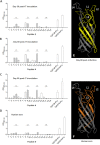Evaluation of the Protective Ability of the Treponema pallidum subsp. pallidum Tp0126 OmpW Homolog in the Rabbit Model of Syphilis
- PMID: 31182617
- PMCID: PMC6652746
- DOI: 10.1128/IAI.00323-19
Evaluation of the Protective Ability of the Treponema pallidum subsp. pallidum Tp0126 OmpW Homolog in the Rabbit Model of Syphilis
Abstract
In silico analyses of Treponema pallidum subsp. pallidum genomes and predicted proteomes to search for homologs of known bacterial outer membrane proteins (OMPs) led to the identification of tp0126 as a gene encoding a putative member of the OmpW family of porins/virulence factors. Our previous investigations on the role of Tp0126 in T. pallidum biology and syphilis pathogenesis showed that Tp0126 is fully conserved among T. pallidum strains and that transcription of tp0126 is driven by σ70 These initial results pointed to a housekeeping function for this protein. We also demonstrated that a guanosine homopolymer of various lengths located between the -10 and -35 consensus sequences in the tp0126 promoter modulates transcription consistently with phase variation, a mechanism that we also previously described for other T. pallidum genes encoding putative OMPs/virulence factors and that is often employed as a strategy for immune evasion. Circular dichroism spectra of recombinant Tp0126 also supported its structural homology with OmpW. Here we further investigated the humoral and cellular responses to Tp0126 during experimental and natural syphilis and the ability of Tp0126 to confer protection against syphilis in immunized rabbits. B-cell epitope mapping showed that compared to sera from experimentally infected animals, immunizations enhanced humoral immunity to sequences located in the putative Tp0126 surface-exposed loops, while phagocytosis assays showed that postimmunization sera opsonized T. pallidum Despite such promising results, no significant protection was seen following infectious challenge in immunized animals versus controls. Functional redundancy and phase variation might explain the lack of effectiveness of this vaccine candidate and/or design.
Keywords: OmpW; Tp0126; Treponema pallidum; functional redundancy; phase variation.
Copyright © 2019 American Society for Microbiology.
Figures





Similar articles
-
Transcription of TP0126, Treponema pallidum putative OmpW homolog, is regulated by the length of a homopolymeric guanosine repeat.Infect Immun. 2015 Jun;83(6):2275-89. doi: 10.1128/IAI.00360-15. Epub 2015 Mar 23. Infect Immun. 2015. PMID: 25802057 Free PMC article.
-
Transcriptional and immunological analysis of the putative outer membrane protein and vaccine candidate TprL of Treponema pallidum.PLoS Negl Trop Dis. 2021 Jan 26;15(1):e0008812. doi: 10.1371/journal.pntd.0008812. eCollection 2021 Jan. PLoS Negl Trop Dis. 2021. PMID: 33497377 Free PMC article.
-
Non-pathogenic Borrelia burgdorferi expressing Treponema pallidum TprK and Tp0435 antigens as a novel approach to evaluate syphilis vaccine candidates.Vaccine. 2019 Mar 22;37(13):1807-1818. doi: 10.1016/j.vaccine.2019.02.022. Epub 2019 Feb 20. Vaccine. 2019. PMID: 30797635 Free PMC article.
-
Progress towards an effective syphilis vaccine: the past, present and future.Expert Rev Vaccines. 2006 Feb;5(1):67-80. doi: 10.1586/14760584.5.1.67. Expert Rev Vaccines. 2006. PMID: 16451109 Review.
-
Polypeptides of Treponema pallidum: progress toward understanding their structural, functional, and immunologic roles. Treponema Pallidum Polypeptide Research Group.Microbiol Rev. 1993 Sep;57(3):750-79. doi: 10.1128/mr.57.3.750-779.1993. Microbiol Rev. 1993. PMID: 8246847 Free PMC article. Review.
Cited by
-
Immunization with a tri-antigen syphilis vaccine significantly attenuates chancre development, reduces bacterial load, and inhibits dissemination of Treponema pallidum.Vaccine. 2022 Dec 12;40(52):7676-7692. doi: 10.1016/j.vaccine.2022.11.002. Epub 2022 Nov 12. Vaccine. 2022. PMID: 36376214 Free PMC article.
-
Immunodominant extracellular loops of Treponema pallidum FadL outer membrane proteins elicit antibodies with opsonic and growth-inhibitory activities.PLoS Pathog. 2024 Dec 23;20(12):e1012443. doi: 10.1371/journal.ppat.1012443. eCollection 2024 Dec. PLoS Pathog. 2024. PMID: 39715273 Free PMC article.
-
Investigation of the immune escape mechanism of Treponema pallidum.Infection. 2023 Apr;51(2):305-321. doi: 10.1007/s15010-022-01939-z. Epub 2022 Oct 19. Infection. 2023. PMID: 36260281 Review.
-
Structural Modeling of the Treponema pallidum Outer Membrane Protein Repertoire: a Road Map for Deconvolution of Syphilis Pathogenesis and Development of a Syphilis Vaccine.J Bacteriol. 2021 Jul 8;203(15):e0008221. doi: 10.1128/JB.00082-21. Epub 2021 Jul 8. J Bacteriol. 2021. PMID: 33972353 Free PMC article.
-
Immunodominant extracellular loops of Treponema pallidum FadL outer membrane proteins elicit antibodies with opsonic and growth-inhibitory activities.bioRxiv [Preprint]. 2024 Jul 30:2024.07.30.605823. doi: 10.1101/2024.07.30.605823. bioRxiv. 2024. Update in: PLoS Pathog. 2024 Dec 23;20(12):e1012443. doi: 10.1371/journal.ppat.1012443. PMID: 39131275 Free PMC article. Updated. Preprint.
References
-
- Radolf JD, Lukehart SA (ed). 2006. Pathogenic Treponema: molecular and cellular biology. Caister Academic Press, Norfolk, England.
-
- World Health Organization. 2011. Prevalence and incidence of selected sexually transmitted infections Chlamydia trachomatis, Neisseria gonorrhoeae, syphilis and Trichomonas vaginalis: methods and results used by WHO to generate 2005 estimates. World Health Organization, Geneva, Switzerland.
-
- Gerbase AC, Rowley JT, Mertens TE. 1998. Global epidemiology of sexually transmitted diseases. Lancet 351(Suppl 3):2–4. - PubMed
Publication types
MeSH terms
Substances
LinkOut - more resources
Full Text Sources

